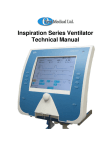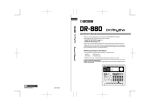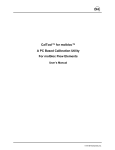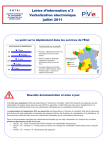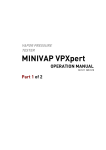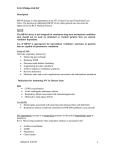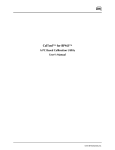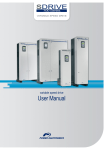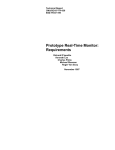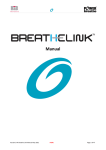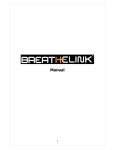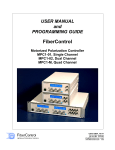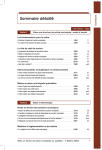Download Inspira 557058 9
Transcript
Harvard Inspira Advanced Safety Ventilator User's Manual Inspira Advanced Safety Ventilator, Volume Controlled 55-7058 Inspira Advanced Safety Ventilator, Pressure Controlled 55-7059 Table of Contents Harvard Apparatus Inspira Advanced Safety Ventilator User's Manual 1 SUBJECT PAGE Warranty and Repair Information ......................................................3 General Safety Summary ....................................................................4 Introduction ..........................................................................................5 Theory of Operation ......................................................................5 Features ........................................................................................5 Installation ......................................................................................7-12 Initial Setup and Location Requirements ......................................7 Typical Operation ..........................................................................7 Ventilator Connections Airway Tubing Connections: Front Panel ............................8 Electrical Connections: Front Panel ....................................9 Electrical Connections: Rear Panel ..................................10 Air Cylinder Installation ................................................................11 Fuse Replacement ......................................................................12 Operation ......................................................................................13-44 Getting Started Turning Ventilator On ........................................................13 Main Operating Screens ....................................................14 Key Functions ....................................................................15 Safe Range™ Respiratory Profiles......................................16 Entering Animal Weight......................................................18 Starting and Stopping Ventilation ......................................19 Displaying Ventilation Parameters ....................................19 Warnings and Faults ..........................................................20 Respiration Profiles Entering Respiration Rate..................................................22 Entering Tidal Volume ........................................................22 Entering Sigh Breath..........................................................23 Disabling Sigh Breath ........................................................23 Entering I:E Ratio ..............................................................25 Entering Pressure Settings (Inspira ASVv) Inspiration Pressure ................................................26 Assist Pressure ........................................................27 Entering Pressure Settings (Inspira ASVp) Inspiration Pressure ................................................28 Assist Pressure ........................................................29 PEEP Pressure ........................................................29 Sigh Pressure ..........................................................30 Table of Contents Harvard Apparatus Inspira Advanced Safety Ventilator User's Manual 2 SUBJECT PAGE Modes of Operation Volume Mode ..........................................................31 Pressure Mode ........................................................31 Assist Mode..............................................................31 Advanced Operation User Override ....................................................................32 Using Digital and Analog I/O Ports ....................................32 Remote Control/Monitoring (Serial Communications) ......33 Changing Air Cylinders ......................................................36 Hardware Setup ................................................................37 Diagnostics ........................................................................39 Power Failure ....................................................................44 General Maintenance and Cleaning ..................................44 Appendices....................................................................................45-56 A. General Specifications ......................................................45 B. I/O Specifications ..............................................................46 C. Serial Commands, Queries and Responses ................47-48 D. Glossary of Terms ..............................................................49 E. Sample Waveforms............................................................50 F. Frequently Asked Questions ........................................51-52 G. Recommended Cylinder Size ............................................53 H. Recommended Port Size ..................................................54 I. Using Inspira with Pressurized and Anesthetic Gasses ....55 J. Generating PEEP with Inspira ASVv ................................56 Warranty and Repair Information Harvard Apparatus Inspira Advanced Safety Ventilator User's Manual 3 Serial Numbers All inquires concerning our product should refer to the serial number of the unit. Serial numbers are located on the rear of the chassis. Calibrations All ventilators are calibrated at rated voltage and frequency. Warranty Harvard Apparatus warranties this instrument for a period of one year from date of purchase.At its option, Harvard Apparatus will repair or replace the unit if it is found to be defective as to workmanship or materials.This warranty does not extend to damage resulting from misuse, neglect or abuse, normal wear and tear, or accident. This warranty extends only to the original customer purchaser. IN NO EVENT SHALL HARVARD APPARATUS BE LIABLE FOR INCIDENTAL OR CONSEQUENTIAL DAMAGES. Some states do not allow exclusion or limitation of incidental or consequential damages so the above limitation or exclusion may not apply to you. THERE ARE NO IMPLIED WARRANTIES OF MERCHANTABILITY, OR FITNESS FOR A PARTICULAR USE, OR OF ANY OTHER NATURE. Some states do not allow this limitation on an implied warranty, so the above limitation may not apply to you. If a defect arises within the one-year warranty period, promptly contact Harvard Apparatus, Inc. 84 October Hill Road, Building 7, Holliston, Massachusetts 01746-1388 using our toll free number 1-800-272-2775. Goods will not be accepted for return unless an RMA (returned materials authorization) number has been issued by our customer service department. The customer is responsible for shipping charges. Please allow a reasonable period of time for completion of repairs, replacement and return. If the unit is replaced, the replacement unit is covered only for the remainder of the original warranty period dating from the purchase of the original device. This warranty gives you specific rights, and you may also have other rights which vary from state to state. Repair Facilities and Parts Harvard Apparatus stocks replacement and repair parts. When ordering, please describe parts as completely as possible, preferably using our part numbers. If practical, enclose a sample or drawing.We offer a complete reconditioning service. CAUTION This apparatus is not registered with the FDA and is not for clinical use on human patients. CAUTION: Not for clinical use on human patients. General Safety Summary Harvard Apparatus Inspira Advanced Safety Ventilator User's Manual 4 Please read the following safety precautions to ensure proper use of your Inspira ventilator. To avoid potential hazards and product damage, use this product only as instructed in this manual. TO PREVENT HAZARD OR INJURY: Use Proper Line Cord Use only the specified line cord for this product and make sure line cord is certified for country of use. Ground the Product This product is grounded through the grounding conductor of the power cord. To avoid electric shock, the grounding conductor must be connected to earth ground. Before making any connections to the input or output terminals of the product, ensure that the product is properly grounded. Make Proper Connections Make sure all connections are made properly and securely. Any signal wire connections to the Inspira unit must be no longer than 3 meters. Observe all Terminal Ratings Review the operating manual to learn the ratings on all Inspira connections. Do Not Operate Without Cover Make sure that the top cover is securely in place before connecting to power source to avoid injury to body and damage to the product. Use Proper Fuse Use only specified fuses with product. Avoid Exposed Circuitry Do not touch any electronic circuitry inside of the product. Do Not Operate with Suspected Failures If damage is suspected on or to the product do not operate the product. Contact qualified service personnel to perform inspection. Place Product in Proper Environment Review the operating manual for guidelines for proper operating environments. Observe all Warning Labels on Product Read all labels on product to ensure proper usage. CAUTION Refer to Manual Protective Ground Terminal Introduction Harvard Apparatus Inspira Advanced Safety Ventilator User's Manual 5 Figure 1. Front view of Inspira Advanced Safety Ventilator Figure 2. Rear view of Inspira Advanced Safety Ventilator Theory of Operation The Inspira is Harvard’s first ventilator that can ventilate animals from mice to cats using the same machine. Its versatility and ease of use allow safer and superior ventilation.The Inspira Ventilator uses an advanced piston/cylinder assembly and a microprocessor controlled actuation mechanism to precisely control respiration profiles. Two interchangeable piston/cylinder assemblies are available to provide a wide range of tidal volumes. The ventilator auto-detects which cylinder, or if no cylinder, is installed. Variable flow valves control the gas flow for inhalation and exhalation. The Inspira ASV Volume Controlled Ventilator delivers the desired tidal volume to the animal by precisely controlling the stroke of the piston. Since actual stroke length (and therefore tidal volume) may be modified for a given stroke, sigh breaths are supported. Since stroke speed is precisely controllable during inspiration and expiration, variable inspiration-to-expiration ratios are also supported. A pressure sensor continuously monitors the airway pressure to prevent over-pressure conditions. Most volume-controlled ventilators presently available do not support sigh breaths and do not provide any pressure monitoring as a safety feature. The Inspira ASVp pressure-controlled ventilator adds pressure control capability to the ASVv volume-controlled platform. Inspiration pressure is limited to the userentered pressure setting. Flow rates are automatically adjusted by the microcontroller by changing the tidal volume while keeping the inspiration time constant. The flow rate is adjusted so that the inspiration pressure limit is reached near the end of the piston stroke, ensuring that animals with a higher airway resistance receive the majority of the expected tidal volume and that the ventilator does not prematurely terminate the piston stroke. No manual adjustment of inspiratory flow rates is required. The ASVp also adds PEEP capability for both the volume- and pressure-control modes. The machine allows a PEEP setting up to 10cmH2O. Features Volume Control Mode The ventilator delivers a known volume of gas to the patient on each inspiration stroke. Respiration frequency and I:E Ratio determine amount of time for inspiration and expiration phases. Introduction Harvard Apparatus Inspira Advanced Safety Ventilator User's Manual 6 Pressure Control Mode (Inspira ASVp Only) The ventilator delivers gas to the patient until the user-selected pressure limit is reached. Flow rate is automatically adjusted by the machine so that the pressure limit is reached near the end of the inspiration time. Respiration frequency and I:E Ratio determine the amount of time for inspiration and expiration phases. Adjustable I:E Ratio This option allows the user to select the ratio of inhalation to exhalation times when advanced respiratory control is needed. This feature is intended to allow greater respiratory control for research. The default I:E Ratio is 50%. Flow-Rate Monitoring (Future Feature) Flow-rate monitoring will allow continuous monitoring of the rate at which the gas is being delivered to the animal. This feature will also aid respiratory research. Programmable Sigh Breath Continuous, long-term ventilation combined with the force of gravity will cause the animal’s lungs to begin to collapse. Introducing a larger than normal tidal volume over-inflates the animal’s lungs, replicating a natural sigh. It allows the lungs to expand and opens the collapsed alveoli. Sigh breaths are supported in both modes. In the volume-controlled mode, a sigh tidal volume is used. In the pressure-controlled mode, a sigh pressure limit is used.The frequency and volume of the sigh breath are user selectable in volume-controlled mode. In the pressure-controlled mode, the frequency and pressure of the sigh breaths are selectable. Respiratory Assist The Inspira ventilator supports Respiratory Assist in both volume-and pressure-controlled modes.This feature is used to wean an animal off the ventilator.When the animal attempts to initiate a breath on its own, a pressure sensor detects the drop in airway pressure.This drop initiates a ventilation cycle.The sensitivity of the Assist Mode is adjustable from –1 to –10 cmH2O. The ventilator lets the animal initiate breaths independently as long as its breathing rate is greater than the respiration rate set by the user or calculated by the microprocessor. If the animal does not try to initiate a breath, Inspira warns the user. Airway Pressure Monitoring The ventilator monitors the pressure of gas delivered to the animal being ventilated. This safety feature prevents the operator from over or under pressurizing the lungs of the animal. When Inspira detects an over-pressurization condition it sounds an alarm, stops the inspiration stroke, and then cycles to expiration. Inspira continues to ventilate but does not deliver enough gas to over-pressurize the lungs. Overpressure conditions may result from occluded or restricted airways. When Inspira detects an under-pressurization condition it sounds an alarm. This condition could result from an airway disconnect or large leaks. Once again, Inspira continues to ventilate while requesting user intervention. These features ensure that the animal is kept safe from improper ventilator setup. PEEP (Inspira ASVp Only) Positive end-expiratory pressure (PEEP) is settable in the Inspira ASVp in both volume -and pressure-controlled modes.The PEEP is adjustable from 0 to 10 cm H2O. Installation Harvard Apparatus Inspira Advanced Safety Ventilator User's Manual 7 Initial Setup 1. Remove unit from box. 2. Remove foam-packing inserts from both ends of the ventilator. 3. Locate and carefully remove air cylinders and power cord from shipping material. 4. Visually inspect both the ventilator and the air cylinders for any damage that might have occurred in the shipping process. The unit is shipped without the air cylinder installed. Please refer to “Air Cylinder Installation” to properly install the cylinder, see pages 11 to 12. 5. The Inspira is shipped from the factory with a North American line cord with a U.S. three wire molded power plug on one end and an IEC320/C13 connector on the other. Use only an approved AC line cord with a molded IEC320/C13 connector certified for country of use. Only connect to grounded power receptacles to help ensure proper grounding; do not use adapter plugs. 6. Read the manual to become familiar with all features and functions of the Inspira. Location Requirements • A sturdy, level, clean, nonflammable and dry surface • Minimum of 1 inch (2.5 cm) clearance around the pump • Adequate power supply • Room temperature 4° to 40°C (40° to 104°F) • Relative humidity of 20 to 80% • A well ventilated room WARNING! Do not use in the presence of explosive gasses or in a 100% oxygen environment. Typical Operation The Inspira ventilator is designed to respirate small animals with a body mass ranging from 15 grams to 10 kilograms. It can operate at respiration rates of 5 to 200 breaths per minute (bpm) and can deliver tidal volumes of 0.1 to 100 cc. It is designed for use in a typical laboratory, operating room, or any other well-ventilated, nonexplosive environment. The Inspira can be used to deliver all types of nonexplosive gas mixtures including, but not limited to, anesthetic gases and 100% oxygen. Installation Harvard Apparatus Inspira Advanced Safety Ventilator User's Manual 8 VENTILATOR CONNECTIONS The Inspira ASV comes with connection ports located on the front and rear panels of the ventilator. These connections are shown on the following pages. Airway Tubing Connections: Front Panel The Inspira ASV provides four airway-tubing connections at the front of the machine. A fifth port (Side Stream) is provided to support advanced options. These ports are standard 1/8”-27 NPT threaded ports and may accept many types of fittings including barbed and luer-lock. This allows for a wide range of tubing sizes and for accommodating air filters, if needed. The functions of these connections are as follows: To Animal Air/Gas Input From Animal Flow of source gas from ventilator to animal. From Animal From Animal Source Flow of expired gas from animal to ventilator. Exhaust To Animal To Animal Exhaust Side Stream Flow of expired air from ventilator. This gas may be vented to room, recirculated for rebreathing, collected, and or filtered if chemicals are present in the expired air. Expired Air CAUTION: Do not vent anesthesia gases to room air. Source “Y” Connector (close to animal) Flow of gas used by Inspira for inspiration. Connect to the source of inspiration gas or leave disconnected to use room air. Side Stream Not used in this model. Tracheal Cannula or Endotracheal Tube Figure 3.Airway Tubing Connections CAUTION: Do not connect Inspira to pressurized gas sources unless proper pressure regulation is provided to equalize the pressure with atmospheric pressure. Failure to do so could result in excessive and unknown tidal volumes delivered to the animal. Installation Harvard Apparatus Inspira Advanced Safety Ventilator User's Manual 9 Figure 4. Front Panel Electrical Connections: Front Panel Inspira provides four BNC type connectors at the front of the machine. Their functions are as follows: Sync Out Produces a digital pulse at the start of the respiration cycle allowing synchronization of other electronic equipment with Inspira’s respiration cycle. Trigger In For use with equipment which uses a digital signal to start and stop respiration. An example of this type of equipment would be a footswitch. Analog Out 1 An analog signal representing the airway pressure within the ventilator. This signal may be monitored with an oscilloscope. Analog Out 2 Not used in this model. Note: Electrical specifications for these signals are given in Appendix A. Installation Harvard Apparatus Inspira Advanced Safety Ventilator User's Manual 10 Electrical Connections: Rear Panel Inspira provides power entry, RS232 communications, and User I/O (Optional) connections at the rear of the machine. Their functions are as follows: User I/O Not used in this model. RS232 In For use with a host computer to establish a communication connection between the computer and the Inspira. Figure 5. Rear Panel 1. No connection 2. Transmit Data (TXD) 3. Receive Data (RXD) 4. Data Terminal Ready Input (DTR)1 5. Signal Ground (GND) 6. No Connection 7. Request to Send Input (RTS)2 Figure 6. RS232 Connector 8. No Connection 9. No Connection 1 Used for Vpp Enable in optional flash programming configuration; disabled in hardware. 2 Used as Serial Reset in optional flash programming configuration; disabled in hardware. RS232 Out Used to establish a daisy chain serial connection with other devices. Future models will support a serial printer connection through this port. 1. No connection 2. Receive Data (RXD) 3. Transmit Data (TXD) 4. No Connection 5. Signal Ground (GND) 6. No Connection 7. No Connection 8. No Connection 9. No Connection Power Connection Power in. Note: Electrical specifications for these signals are given in Appendix A. Installation Harvard Apparatus Inspira Advanced Safety Ventilator User's Manual 11 Large Air Cylinder Small Air Cylinder O-Ring Front Switch Rear Switch Flag Pin White Plunger Lead Screw Coupling Valve Block Figure 7.Air Cylinder Installation Air Cylinder Installation Key Information 1. Use ONLY Harvard Apparatus approved air cylinders. Any other nonapproved cylinders may damage the Inspira unit. 2. Do not oil or grease the air cylinders. Inspira’s special air cylinders are selflubricating, requiring no additional lubrication.Applying oil or grease may damage the air cylinders. 3. When switching the air cylinders, the power must be SWITCHED OFF. 4. Tampering with any components besides the air cylinders inside of the Inspira will void the warranty. CAUTION: Electrostatic discharge (ESD) can damage components on the circuit boards. Avoid contact with the circuit boards when changing cylinders. Procedure Before the Inspira can be used for the first time, one of the two provided air cylinders (10 cc and 100 cc) must be installed. Choose the proper cylinder depending on the size of the animal to be ventilated. Remove the top cover of the ventilator by removing the seven phillips head screws which hold the top cover in place. Once the top cover is removed locate the mounting area for the air cylinders as seen in figure 7. Place the small provided O-ring in the mounting groove, which is found on the valve block as illustrated. Then move Inspira’s white plunger back by turning the coupling connecting the black lead screw to the motor shaft. Turn the lead screw until the flag Installation Harvard Apparatus Inspira Advanced Safety Ventilator User's Manual 12 pin on the rear of the plunger is vertically in-line with the rear switch as illustrated. (Note: When installing the air cylinder, do not change the bends of the cylinder detection switches or else the correct cylinder will not be detected.) Now insert the cylinder by placing the plunger portion of the air cylinder on the end of Inspira’s white plunger. Carefully slide the air cylinder back on the white plunger compressing the air cylinder just enough to allow the front end of the cylinder to be lowered into place. Once the air cylinder is fit in place, screw the air cylinder’s threaded nipple into the valve block and hand tighten the cylinder in place. CAUTION: Do not overtighten the cylinder. Overtightening the cylinder can cause the glass cylinder to crack. Now that the air cylinder is in place, rotate the lead screw to position the flag pin in between both the front and rear switches. To complete the installation,replace the top cover of the Inspira unit. When Inspira is powered on it should display the correct cylinder size after initializing. Fuse Replacement Key Information 1. Make sure the power cord is disconnected from the main supply before servicing the fuse. 2. Use only Type 3AG, 1/4” x 11/4”, 1 amp, 250 volt,Type T (time delay) fuses (Harvard Apparatus part number 5113-033 or equivalent). Turn off power and remove power cord from power module. Use a straight blade screwdriver to pry open the access door. Remove the fuse holder and then remove the fuses from this holder as shown in figure 8 below. Replace fuses using only 1 amp, 250 volts,Type T fuses. Then replace the fuse holder. Note: A fuse, which is not operator replaceable, is located on the power supply. This fuse is rated 5 amps, 250 volts. Figure 8. Fuse Replacement Operation: Getting Started Harvard Apparatus Inspira Advanced Safety Ventilator User's Manual 13 Vt xxx.xxcc R VOL RATE xxxBPM >>>> Set Rate Volume Weight Sigh I:E Ratio Pressure RS232 Tidal Volume Select Mode 1 2 3 4 5 6 7 8 9 C 0 . Run Stop Enter Remote Indication Ventilation Mode Vt xxx.xxcc R VOL RATE xxxBPM >>>> Respiration Rate Run/Stop Figure 9. Main Operating Screen, Volume-Control Mode Turning Ventilator On Power must be properly supplied to the ventilator, according to the power specifications. Locate the power switch on the rear of the ventilator. Toggle the switch so that the “I” side of the switch is pressed down. The ventilator is now powered on. Volume-Controlled Ventilation With machine powered ON, press and release the SELECT MODE key until VOL mode is selected. Press SET and WEIGHT and enter the animal’s weight in kg. Press and hold parameter keys in order to verify respiration parameters. If any parameters need to be changed, press the SET key and the appropriate parameter key and enter the value to set. Press and release the RUN/STOP key to start ventilation. Pressure-Controlled Ventilation (Inspira ASVp Only) With machine powered ON, press and release the SELECT MODE key until PRES mode is selected. Press SET and WEIGHT and enter the animal’s weight in kg. Press and hold parameter keys in order to verify respiration parameters. If any parameters need to be changed, press the SET key and the appropriate parameter key and enter the value to set. Press and release the RUN/STOP key to start ventilation. Operation: Getting Started Harvard Apparatus Inspira Advanced Safety Ventilator User's Manual 14 Main Operating Screens The main operating screen is the default display. This screen displays the operating mode, current operating variables, such as tidal volume and respiration rate, and the status of the ventilator (stopped or running). Main Operating Screen – Pressure Control Mode P a w X X c m H 2O P R E S Rate XXX BPM R >>>> Main Operating Screen – Pressure Assist Control Mode P a w X X c m H 2O P R S A S S T Rate XXX BPM R >>>> Main Operating Screen – Volume Control Mode Vt XXX.XX cc VOL RATE XXX BPM R >>>> Main Operating Screen – Volume Assist Control Mode Vt XXX.XX cc VOLASST RATE XXX BPM R >>>> Paw Average Peak Pressure in cmH2O Vt Tidal Volume in cc Rate Respiration Rate in BPM R Remote Mode Indication Operation: Getting Started Harvard Apparatus Inspira Advanced Safety Ventilator User's Manual 15 Vt xxx.xxcc R VOL RATE xxxBPM >>>> Set Rate Volume Weight Sigh I:E Ratio Pressure RS232 Set Keys Select Mode 1 2 3 4 5 6 7 8 9 C 0 . Run Stop Toggle Keys Enter Data Entry Keys Figure 10. Front Panel Set Keys Toggle Keys Set Pressing these keys toggle through the successive states of the key’s function. Allows modification of a data item. To modify a data item, press the relevant key after pressing the [Set] key. Also used to toggle different options when prompted. Run/Stop Rate Starts/Stops the ventilator. When stopping, the ventilator will finish its current stroke before ceasing ventilation. Displays/Sets current respiration rate. Select Mode Volume Toggles through available run modes with each press of the key. It is also used to select entry choices in hardware setup. Displays/Sets current tidal volume in volume mode. Weight Displays/Sets current animal weight. Sigh Data Entry Keys Displays/Sets sigh parameters and manually triggers a sigh breath. 1, 2, 3, 4, 5, 6, 7, 8, 9, 0, • I:E Ratio Displays/Sets the current inspiration to expiration (I:E) ratio. Pressure Displays/Sets pressure limits. RS232 Displays/Sets current RS232 device(s) attached. Used to enter numeric data values or access special features. C Clear; clears numeric data values prior to entry. Enter Saves and stores displayed data value in memory when setting a data item. Operation: Getting Started Harvard Apparatus Inspira Advanced Safety Ventilator User's Manual 16 Safe Range™ Respiratory Profiles Setting up the ASV ventilator is both easy and safe thanks to the Safe Range™ software. Once the animal’s body weight has been entered the software computes the median settings for tidal volume and respiratory rate.These same equations are used to calculate a Safe Range™ around the median values. Inspira uses the entered weight to calculate the correct tidal volume and respiratory rate for the animal. The tidal volume (in liters) is determined by the equation 0.0062 x Mb1.01 where Mb is the animal mass in kilograms. The respiratory rate (in min-1) is determined by the equation 53.5 x Mb-0.26. The Safe Range™ is established by computing a range of acceptable values, which are less than or equal to ±10% of the calculated tidal volume and respiratory rate. All the default parameter settings can be overridden. If you enter a setting outside of the Safe Range™ for the body mass of the animal to be ventilated you are warned that the value is outside the Safe Range™ and asked to confirm the setting. SAFE RANGE – Pressure-Control Mode Inspiration Pressure Range Safe Range: 15 to 25 cmH2O Full Range: 5 to 50 cmH2O Sigh Pressure Range Safe Range: Insp. Pressure to (Insp. Pressure + 10cmH2O) or 35cmH2O, whichever is less Full Range: Insp. Pressure to 50cmH2O Operation: Getting Started Ventilator Graph The graph labeled as figure 11 below shows tidal volume vs. body mass and rate for laboratory mammals in a resting state. (Apparatus dead space must be added.) 100 70 200 300 400 600 800 1 3 2 4 5 6 8 10 15 20 30 500 Tidal Volume (ml at Ambient Temperature) Harvard Apparatus Inspira Advanced Safety Ventilator User's Manual 17 40 500 400 400 300 300 200 200 150 150 100 100 80 80 60 50 60 50 Breaths per Minute: 10 40 40 40 30 30 15 50 20 20 20 15 15 25 60 10 8 10 8 70 80 90 30 6 6 5 5 4 4 100 3 3 2 2 40 1 1 0.8 0.8 0.6 0.5 0.6 0.5 0.4 0.4 70 100 200 300 400 600 800 1 (Grams) 3 2 4 Body Mass 5 6 8 10 (Kilograms) Figure 11.Ventilator Graph Ventilation Parameters Mammals with <70g Body Mass Body Mass (g) Vt (ml) Rate (BPM) 15 0.1 159 20 0.12 148 30 0.18 133 40 0.24 123 50 0.30 117 60 0.36 111 70 0.42 107 15 20 30 40 Operation: Getting Started Harvard Apparatus Inspira Advanced Safety Ventilator User's Manual 18 Entering Animal Weight Key Information • The Inspira can handle animal weights ranging from 0.015 to 10.00 kilograms. • The large cylinder can handle masses between 0.160 and 10.00 kilograms and the small cylinder can handle masses between 0.015 and 0.59 kilograms. • Entering an animal’s weight will allow Inspira to automatically choose a Safe Range™ tidal volume and respiration rate. No extra setup is required. To enter the animal’s weight, press the [Set] key. The display should now read “Press parameter key”. Press the [Weight] key. The display will now read “Enter Weight (Kg)”. Simply use the numeric keypad and decimal point key to enter the proper weight (between 15 g and 10 kg). The weight must be entered in kilograms. Inspira will allow for the entry of up to three decimal places. After entering the weight press the [Enter] key. The display should read “Change SV and BPM” (stroke volume and breaths per minute). Use the [Set] key to move the bar cursor to select either “yes” or “no”. Press [Enter] to select your choice. Selecting yes will change the SV and BPM to the automatically calculated Safe Range™ ventilation settings. Selecting no will leave the previously used SV and BPM settings, which may not be safe for the animal. Step Key 1 Set 2 Weight Display Press Parameter Key Enter Weight (kg) _ Enters weight configuration mode 3 . 1 2 3 4 Enter Weight (kg) 1.234 Selects weight 4 Enter Yes No Change SV and BPM? Enters weight 5 Set Moves cursor to select yes or no 6 Enter Selects choice and returns to main screen 7 Run Stop Starts and stops ventilation Yes No Change SV and BPM? Operation: Getting Started Harvard Apparatus Inspira Advanced Safety Ventilator User's Manual 19 Starting and Stopping Ventilation To start and stop ventilation simply press the [Run/Stop] key. When stopping, Inspira will finish its current stroke before stopping completely. The valve will always be in the expiration position when a STOP has been commanded. Displaying Ventilator Parameters Inspira allows you to easily check the current ventilation parameters by using one key commands. To display a specific parameter, simply press and hold the appropriate key. Key Display Rate Resp Rate xxxBPM Displays current respiration rate Volume Tidal Vol xxx.xxcc Sigh Vol xxx.xxcc Displays current tidal volume and sigh volume (volume-control mode) Volume Tidal Vol xxx.xx cc Displays current tidal volume (pressure control mode) Weight Weight xx.xxxkg Displays current weight setting Sigh Sigh Vol xxx.xxcc Sigh Freq 1/xxx Displays sigh breath settings Sigh Sigh Pres Sigh Freq xx c m H 2 O 1/xxx Displays sigh breath settings (pressure control mode) I:E Ratio %Inspiration xx% Displays I:E ratio settings Pressure Insp P Limit xxcmH2O Assist P -xxcmH2O Displays current pressure settings Pressure Paw xx EEP xx Asst -x Plim xx PEEP xx c m H 2 O Displays current pressure settings (ASVp) RS232 Displays current RS232 setting Baud = xxxx Bits = 1,8,x,x Operation: Getting Started Harvard Apparatus Inspira Advanced Safety Ventilator User's Manual 20 Warnings and Faults Pump Stall P um p St al l A l a r m Stop This fault indicates that the expected motion of the piston axis does not match the actual motion. This is a critical fault and requires operator intervention.The valve is set to the expiration position and the machine is commanded to STOP. The user is always notified via a visual alarm and also by an audible alarm (if enabled). Valve Stall V al ve S ta l l A l a r m Stop This fault indicates that the expected motion of the valve axis does not match the actual motion. This is a critical fault and requires operator intervention. The machine is commanded to STOP. The user is notified via a visual alarm and audible alarm (if enabled). Motor Drive Fault M ot or D ri v e F a u l t Stop This fault indicates a problem with the step motor drive. This is a critical fault and requires operator intervention. The machine is commanded to a STOP state. Airway Over-Pressure O ve rp re ss u r e A l a r m This fault indicates that an overpressure condition has been detected in the airway. The user is always notified via a visual alarm and also by an audible alarm (if enabled). An overpressure in Volume Control mode is defined as a pressure greater than the average measured peak pressure (averaged over 10 samples, not counting sigh breaths) plus 10 cmH2O, or 67cmH2O, whichever is smaller.This limit is adjusted during sigh breaths to 150% of the average value or 67 cmH2O, whichever is smaller.The optional user-entered inspiration pressure limit is used as a secondary pressure check. The default limit is 35 cmH2O. If the average pressure should rise up and exceed this value, the user is notified via a visual alarm and also by an audible alarm (if enabled). Airway overpressure conditions cause the inspiration stroke to stop; the machine immediately cycles to expiration. After completing expiration, the machine will continue to run the current respiration profile, repeating the above steps if the overpressure condition continues. If the fault is cleared, the alarms (visual and audible) will selfclear. Otherwise, the alarms will continue, requesting operator intervention. Operation: Getting Started Harvard Apparatus Inspira Advanced Safety Ventilator User's Manual 21 Occlusion Alarm (Inspira ASVp Only) Oc cl us io n A l a r m If the peak pressure limit is reached within the first 40% of the inspiration stroke, an occlusion alarm is reported. This indicates that a restriction may be present in the airway or that the airway resistance may be too high for the flow rate. Occlusions, system restrictions due small tubing and/or port diameters, or incorrect respiratory parameters could be the cause.This alarm is self-clearing on removal of the fault condition. Assist Alarm A ss is t Al a r m This fault indicates that a vacuum trigger, which is generated by an inhalation effort by the patient, has not been detected on 5 consecutive cycles.This would be a result of the patient failing to initiate breaths on its own or of improper respiration parameter settings, such as assist pressure threshold or respiration rate. Airway Under-Pressure Un de rp re s s u r e A l a r m This fault indicates that an under-pressure condition has been detected in the airway. For Volume Control mode, an under-pressure condition is defined as a pressure less than 25% of the average measured peak pressure (averaged over 10 samples,not counting sigh breaths), checked at a time approximately halfway into the inspiration stroke. This could indicate that the airway is not connected or is leaking.This is a critical fault and requires operator intervention. The machine shall continue to run at the current respiratory settings. This fault shall be self-clearing once the condition is corrected. The user is always notified via a visual alarm and also by an audible alarm (if enabled). Underpressure Alarm (Inspira ASVp) Un de rp re s s u r e A l a r m If the average airway pressure is less than 3cmH20, an underpressure alarm is reported. Underpressure conditions are generally caused by severe system leaks.This alarm is self-clearing on removal of the fault condition. Initialization Fault I ni ti al iz a t i o n F a u l t This fault indicates that the machine failed to initialize properly due to one or more reasons. High PEEP Alarm (Inspira ASVp Only) Hi gh P EE P A l a r m If the actual end-expiratory pressure (EEP) exceeds the desired PEEP plus 5cmH20 or 11cmH2O, whichever is less, a High PEEP Alarm is reported. This alarm is self-clearing on removal of the fault condition. Operation: Respiration Profiles Harvard Apparatus Inspira Advanced Safety Ventilator User's Manual 22 Entering Respiration Rate To enter a custom respiration rate press the [Set] key followed by the [Rate] key. The display should now read “Enter Resp Rate”. Enter the rate in breaths per minute (BPM) using the numeric keypad. Only whole numbers will be accepted as valid rates. Press the [Enter] key to enter the selected rate. If the selected rate is not within the Safe Range™ a prompt will ask if you would like to override the Safe Range™ value; see page 32. Step Key 1 Set 2 Rate Display Press Parameter Key Enter Resp Rate _ (BPM) Enters respiration rate configuration mode 3 2 1 Enter Resp Rate 123 (BPM) 3 Selects rate in breaths per minute 4 Enter Enters choice and returns to main screen Entering Tidal Volume (Volume-control Mode Only) • The inspiration and expiration volumes are always the same. To enter a custom inspiration/expiration volume press the [Set] key followed by the [Volume] key. The display should now read “Enter Tidal Vol”. Use the numeric keypad to enter the inspiration/expiration volume. Press the [Enter] key to enter the selected volume. If the selected volume is not within the Safe Range™ a prompt will ask if you would like to override the Safe Range™ value; see page 32. Step Key 1 Set 2 Volume Display Press Parameter Key Enter Tidal Vol (cc) _ Enters volume configuration mode 3 1 2 . 3 Selects volume 4 Enter Enters choice and returns to main screen Enter Tidal Vol (cc) 12.3 Operation: Respiration Profiles Harvard Apparatus Inspira Advanced Safety Ventilator User's Manual 23 Entering Sigh Breath (Volume-control Mode) • A sigh tidal volume (STv) and a sigh frequency must be set in order to activate the sigh breath function in volume-control mode. To enter a sigh tidal volume and a sigh frequency press the [Set] key followed by the [Sigh] key. The display will now read “Enter Sigh Volume” and will also show the current STv. Use the numeric keypad to enter the desired STv. Press [Enter] to enter selected STv. Inspira will now ask for the desired sigh frequency. The display should read “Enter Sigh Freq, 1sigh/__ breaths”. Again, use the numeric keypad to enter the ratio of sigh breaths to regular breaths (Note: Inspira will only accept whole numbers for this ratio). Press the [Enter] key to enter the selected ratio. If the selected values are out of the Safe Range™ a prompt will ask you if you would like to override the Safe Range™ value; see page 32. Step Key 1 Set 2 Sigh Display Press Parameter Key Enter Sigh Volume STv: _ (cc) Enters sigh configuration mode 3 2 1 . 3 Enter Sigh Volume STv: 12.3 (cc) Selects sigh volume 4 Enter Sigh Freq: 1 Sigh/ _ Breaths Enter Enters sigh volume; returns prompt for sigh frequency 5 1 2 Enter Sigh Freq: 1 Sigh/ 12 Breaths Selects sigh frequency 6 Enter Enters choice and returns to main screen Entering Sigh Breath (Pressure-Control Mode) A sigh pressure and sigh frequency must be set in order to activate the sigh breath function in pressure-control mode. Disabling Sigh Breath To disable sigh breaths, enter Sigh Volume = Tidal Volume (volume-control mode) or set Sigh Frequency to 1 sigh / 0 breaths. SIGH BREATHS ARE AUTOMATICALLY DISABLED WHENEVER A NEW ANIMAL WEIGHT IS ENTERED. Operation: Respiration Profiles Harvard Apparatus Inspira Advanced Safety Ventilator User's Manual 24 Sigh Pressure (Pressure-Control Mode Only) Step Key 1 Set 2 Sigh Display Press Parameter Key E n t er Sigh Pressure _ ( cmH2O) Enters sigh configuration mode 3 3 5 E n t er Sigh Pressure 3 5 (cmH2O) Selects sigh pressure 4 E n t er Sigh Freq: 1 S igh/ _ Breaths Enter Enters sigh pressure; returns prompt for sigh frequency 5 1 2 Selects sigh frequency E n t er Sigh Freq: 1 S igh/ 12 Breaths Operation: Respiration Profiles Harvard Apparatus Inspira Advanced Safety Ventilator User's Manual 25 Entering I:E Ratio • • • The I:E ratio is the ratio of the time needed for inhalation compared to time needed for exhalation.The volume of the inhalation breath is always the same as the volume of the exhalation breath. There are no predetermined safe range values for I:E ratios. The default I:E ratio is 50% To enter a different I:E ratio press the [SET] key followed by the [I:E RATIO] key. The display should now read “Enter % Inspiration, (20%-80%)”. Use the numeric keypad to enter the whole number percentage of inspiration (which must be between 20 and 80). The percent of expiration is determined from the value for inspiration. (Note: Due to electromechanical system limitations, Inspira might not accept some I:E Ratio values for certain respiration profiles. If a desired I:E ratio is not accepted when using the small cylinder, try switching to the larger cylinder. This may allow acceptance of the desired ratio.) Step Key 1 Set 2 I:E Ratio Display Press Parameter Key Enter %Inspiration (20%-80%): _ Enters I:E ratio configuration mode 3 4 0 Selects inspiration ratio 4 Enter Enters inspiration ratio and returns to main screen Enter %Inspiration (20%-80%): 40 Operation: Respiration Profiles Harvard Apparatus Inspira Advanced Safety Ventilator User's Manual 26 Entering Pressure Settings (Inspira ASVv) Inspiration Pressure The Inspiration pressure is a pressure threshold, which is used to detect airway overpressure conditions. If the average airway pressure rises above this pressure threshold, an alarm is sounded (if enabled) and the display shows the fault.This indicates that the residual volume may be increasing in the animal’s lungs and user intervention is required immediately. Ventilation will still occur after this threshold has been broken. The default Inspiration Pressure is 35 cmH2O.To set the inspiration pressure press the [Set] key followed by the [Pressure] key. The display should now display a list of options “Press 1=Insp, 2=Asst”. Press the [1] on the numeric keypad to select the inspiration pressure. The display should now read “Enter Insp Pressure”and display the current pressure setting. Using the numeric keypad, enter the inspiration pressure setting in cmH2O. Inspira will only accept whole number values for this setting. Press [Enter] to enter the selected pressure setting. Step Key 1 Set 2 Pressure Display Press Parameter Key PRESS 1=INSP 2=ASST Enters pressure configuration mode 3 Enter Insp Pressure: _ (cm H2O) 1 Enters inspiration pressure setup 4 3 0 Selects inspiration pressure 5 Enter Enters inspiration pressure and returns to main screen Enter Insp Pressure: 30 (cm H2O) Operation: Respiration Profiles Harvard Apparatus Inspira Advanced Safety Ventilator User's Manual 27 Assist Pressure The assist pressure is a sub-baseline pressure threshold which is used to trigger an inspiration stroke. Inspira looks for this trigger within the first 10% of the calculated inspiration time, which is determined by the inspiration rate. The default Assist Pressure is -5 cmH2O. • The ASV will always use a negative assist pressure. To set the assist pressure press the [Set] key followed by the [Pressure] key. The display should now show a list of options “Press 1=Insp, 2=Asst”. Press [2] on the numeric keypad to select the assist pressure. Now the display should read “Enter Assist Pressure” and also show the current assist pressure setting. Use the numeric keypad to enter the vacuum pressure (the negative sign does not need to be entered, Inspira assumes that this value is negative). Press the [Enter] key to enter the selected assist pressure value. Step Key 1 Set 2 Pressure Display Press Parameter Key PRESS 1=INSP 2=ASST Enters pressure configuration mode 3 2 Enter Asst Pressure: -_ (cm H2O) Enters assist pressure setup 4 5 Selects assist pressure 5 Enter Enters assist pressure and returns to main screen Enter Asst Pressure: -5 (cm H2O) Operation: Respiration Profiles Harvard Apparatus Inspira Advanced Safety Ventilator User's Manual 28 Entering Pressure Settings (Inspira ASVp) Inspiration Pressure Step Key 1 Set 2 Pressure Display Press Parameter Key P R ESS 1=INSP 3=PEEP 2=ASST 4=SIGH 1 Enters pressure configuration mode 3 E n ter Insp Pressure: _ (cm H2O) 1 Enters inspiration pressure setup 4 3 0 E n ter Insp Pressure: 30 (cm H2O) Selects inspiration pressure 5 Enter Enters inspiration pressure and returns to main screen Note 1: Sigh pressure setting only available in pressure-control mode. Operation: Respiration Profiles Harvard Apparatus Inspira Advanced Safety Ventilator User's Manual 29 Assist Pressure Step Key 1 Set 2 Pressure Display Press Parameter Key P R E SS 1=INSP 3=PEEP 2=ASST 4=SIGH 1 Enters assist pressure configuration mode 3 E n t er Asst Pressure: -_ (cm H2O) 2 Enters assist pressure setup 4 E n t er Asst Pressure: - 5 (cmH2O) 5 Selects assist pressure 5 Enter Enters assist pressure and returns to main screen Note 1: Sigh pressure setting only available in pressure-control mode. PEEP Pressure Step Key 1 Set 2 Pressure Display Press Parameter Key P R E SS 1=INSP 3=PEEP 2=ASST 4=SIGH 1 Enters peep pressure configuration mode 3 3 E n t er PEEP Pressure: _ (cm H2O) Enters peep pressure setup 4 5 E n t er PEEP Pressure: 5 ( cmH2O) Selects peep pressure 5 Enter Enters peep pressure and returns to main screen Note 1: Sigh pressure setting only available in pressure-control mode. Operation: Respiration Profiles Harvard Apparatus Inspira Advanced Safety Ventilator User's Manual 30 Sigh Pressure (Pressure-Control Mode Only) Step Key 1 Set 2 Pressure Display Press Parameter Key PRESS 1=INSP 2=ASST 3=PEEP 4=SIGH 1 Enters weight configuration mode 3 Enter SIGH Pressure: _ (cmH2O) 4 Selects weight 4 3 5 Enter SIGH Pressure: 35 (cmH2O) Enters weight 5 Enter Enter Sigh Freq: 1 Sigh/_ Breaths Moves cursor to select yes or no 6 12 Selects choice and returns to main screen 7 Enter Starts and stops ventilation Enter Sigh Freq: 1 Sigh/12 Breaths Operation: Respiration Profiles Harvard Apparatus Inspira Advanced Safety Ventilator User's Manual 31 Operating Modes The Inspira ASVv has two operating modes, Volume Mode and Assist Mode.To toggle between the modes press the [Select Mode] key. The upper right hand corner of the display will show which mode the ventilator is currently in, either VOL or ASST. The Inspira ASVp has four operating modes – VOLUME, VOLUME ASSIST, PRESSURE, and PRESSURE ASSIST. To toggle between the modes, stop the machine by pressing the RUN/STOP key (if it is presently running) and then press the SELECT MODE key. When the mode is switched from VOLUME ASSIST to PRESSURE or PRESSURE ASSIST to VOLUME, the machine will re-initialize to place it in its "home" position for that mode. The upper right hand corner of the display will show which mode the ventilator is currently in - VOL,VOLASST, PRES, or PRSASST. Volume Mode When in Volume Mode the ventilator delivers a known volume of gas to the animal over a specified amount of time for each respiration stroke. This is the basic operating mode for volume-controlled ventilation. Pressure Mode (Inspira ASVp Only) When in Pressure Mode, the ventilator delivers gas until the desired airway pressure is reached or the end of the inspiration cycle has occurred. If the airway pressure is not reached within the inspiration time, the machine will automatically adjust the inspiratory flow rate by incrementally increasing the tidal volume until the pressure limit is achieved. If the pressure limit is reached early in the inspiratory cycle, the machine will automatically decrease the flow rate so that the limit is reached toward the end of the cycle. If the limit is reached very early in the cycle, the machine will also report an Occlusion Fault. Volume Assist Mode Pressure Assist Mode (Inspira ASVp only) Assist mode is a more advanced mode used to help wean animals off of mechanical respiration. This mode detects when the animal is trying to breathe on its own via a drop in the airway pressure. This mode allows the animal to initiate the respiration strokes. The ventilator starts a respiration stroke when the airway pressure falls below a user-defined threshold. If five respiration strokes occur without the airway pressure dropping below the assist pressure threshold, the animal may not be trying to initiate a breath. The ventilator will continue to operate in the current assist mode but the assist alarm will sound to request user intervention. The user may adjust the respiration parameters and/or the assist pressure to obtain correct performance. CAUTION: Assist Mode should only be used when trying to wean animals from mechanical ventilation. Key Select Mode Toggles between available modes Operation: Advanced Harvard Apparatus Inspira Advanced Safety Ventilator User's Manual 32 User Override The user has the option of overriding the machine’s “Safe Range™” limits to allow for more advanced respiratory control. The Safe Range™ is defined as ±10% of the machine's recommended tidal volume and ±10% of the machine’s recommended respiration rate. When you would like to change a respiration parameter simply enter the value according to the steps provided in the Getting Started section. If the value is outside of the Safe Range™,Inspira will ask you if you would like to override the current Safe Range™ parameter. On this prompt screen press [1] to select “Yes” or [2] for “No”. Note: Some parameters may not be valid due to current respiration profile, cylinder size, and electromechanical limitations. WARNING: Overriding Safe Range™ may be harmful to the patient. Key Display OUT OF RANGE OVERRIDE (1=Y 2=N)? Safe Range prompt 1 Overrides Safe Range or 2 Maintains Safe Range Using Digital and Analog I/O Ports Trigger In This is an active low, digital signal, used to trigger the ventilator between the RUN and STOP modes. Each pulse given to Inspira through this channel will toggle the machine to the next state. This optional signal is input by the user through the use of a footswitch or other device connected to the front panel BNC connector. Minimum input pulse width = 1 ms. Sync Out (Inspira ASVv) This is an active-low, open-collector, digital signal generated at the start of each inspiration stroke. This signal is available at the front panel through a BNC connector. The pulse width equals 20 ms ±10 ms. This signal can be used in conjunction with other devices, which need to operate in sync with the ventilator’s respiration stroke. The falling edge must be used for sync timing. Sync Out (Inspira ASVp) The sync signal is a logic high for the duration of the inspiration time and a logic low during the expiration time. The rising edge corresponds to the start of the inspiration cycle and the falling edge corresponds to the start of expiration. Analog Out The analog out (ANALOG OUT 1) is used to measure the ventilator’s airway pressure. This output can be monitored using a data acquisition system or by an oscilloscope. To view or record this signal, connect the data acquisition system or oscilloscope to the analog out BNC connector on Inspira’s front panel. Operation: Advanced Harvard Apparatus Inspira Advanced Safety Ventilator User's Manual 33 Remote Control / Monitoring (Serial Communication) The Inspira is equipped for serial communication through two RS232 ports. Inspira uses a Harvard Apparatus Command Line protocol as the basis of its serial commands. These serial commands can be found in Appendix C. RS232 Cable Selection To connect PC/At or laptop computers you will need a 9-pin male to 9-pin female shielded cable; Harvard Apparatus part number 5154-353. For PCs with a 25-pin serial port connection, use a 9-pin male to 25-pin female shielded cable; 5154-527. Note: Do not use a “Null-Modem” type cable. RS232 Cable Connection • • • • • Use correct cable. The recommended cable length is 3 meters maximum. Turn power off to Inspira and to the external device before connecting the cable into the connectors. Check that the Inspira signal ground (pin 5) is connected to the external device signal ground. Use shielded cabling to connect Inspira’s chassis ground to the chassis ground of the external device. Serial Communication Setup To configure Inspira for serial communications, press [Set] key followed by the [RS232] key.The display should read “RS232 Setup, Enter to Continue”. Press [Enter] key to display the RS232 input/output selection menu.The display should now read “Press 1=Input port, 2=Output port”. Select the port you would like to configure (Input is used for serial connection to a pc; Output is used for a daisy chain setup).The display should now show the RS232 port setup menu which reads “Press 1=Baud, 2=Bits, 3=Parity, 4=Addr”. Step Key 1 Set 2 RS232 Display Press Parameter Key RS232 SETUP ENTER TO CONTINUE Enters RS232 configuration 3 Enter PRESS 1=INPUT PORT 2=OUTPUT PORT Enters port selection menu 4 1 PRESS 1=BAUD 2=BITS 3=PARITY 4=ADDR Selects input port and enters port configuration menu or 2 Selects output port and enters port configuration menu PRESS 1=BAUD 2=BITS 3=PARITY 4=ADDR Operation: Advanced Harvard Apparatus Inspira Advanced Safety Ventilator User's Manual 34 Data Transfer Rate Configuration To configure the data transfer rate, enter the port configuration menu. Press [1] to enter the Baud rate setup screen. The display should read “Press Select Mode to toggle baud”and display current baud rate. Press the [Select Mode] key to toggle through the baud rates (38400, 19200, 9600, 2400, and 1200). Pressing the [Enter] key will accept the valve and return Inspira to the main screen. Default baud rate is 9600. Step* 5 Key Display 1 PRESS SELECT MODE TO TOGGLE BAUD xxxxx Enters baud rate setup screen 6 Select Mode PRESS SELECT MODE TO TOGGLE BAUD xxxxx Toggles baud 7 Enter Accepts value and returns to main screen Start, Word, and Stop Bit Configuration To change the bit configuration, enter the port configuration menu by pressing [2]. The display should read “Define Serial Bits, STRT,WD, STP”, and display the current bit settings respectively. The start bit is fixed at 1 bit and word bits are fixed at 8. Use the numeric keypad to change the number of stop bits. Press [Enter] to return to the main screen. Step* 5 Key Display DEFINE SERIAL BITS STRT,WD,STP 1,8,x 2 Enters bit setup screen 6 DEFINE SERIAL BITS STRT,WD,STP 1,8,1 1 Changes stop bits to 1 or DEFINE SERIAL BITS STRT,WD,STP 1,8,2 2 Changes stop bits to 2 7 Enter Accepts entry and returns to main screen * Note: See page 33 for steps 1 through 4. Operation: Advanced Harvard Apparatus Inspira Advanced Safety Ventilator User's Manual 35 Parity Configuration To configure the port parity settings, enter the port configuration menu. Press [3] to enter the parity configuration menu. The display should read “Define Parity: 1= Even, 2= Odd, 3= None”. Choose the desired parity by pressing the corresponding numeric key. After making your selection Inspira will automatically return to the main screen. The default parity is “none”. Step* 5 Key Display DEFINE PARITY x 1=EVEN 2=ODD 3=NONE 3 Enters bit setup screen 6 3 Changes parity parameter and returns to main screen Address Configuration (Future Feature) To assign an address to the Inspira for use in a daisy chain, enter the port setup menu. Press [4] to enter the address configuration menu. The display should read “Enter Address” and display Inspira’s current address. Use the numeric keys to enter an address between 0 and 999. Press [Enter] to enter the selected address and to return to the main screen. Step* 5 Key Display ENTER ADDRESS _ 4 Enters address setup screen 6 1 0 ENTER ADDRESS 10_ Selects address 7 Enter Enters address and returns to main screen Testing RS232 Communication Once Inspira and the external device are configured with the same port settings, connect the Inspira to the external device using the proper cable. Send the VER command from the external device to Inspira. If the RS232 connection is working properly the Inspira will return its version number. If nothing is returned, check the cable connection and the port settings to verify that they are configured correctly. * Note: See page 33 for steps 1 through 4. Operation: Advanced Harvard Apparatus Inspira Advanced Safety Ventilator User's Manual 36 Changing Air Cylinders The Inspira ventilators use two easily interchangeable piston/cylinder assemblies. These assemblies are available to provide 0.1 to 10 ml and 1 to 100 ml tidal volumes. Changing the piston/cylinder assembly is simple. Remove the top cover of the ventilator by removing the seven phillips head screws which hold the top cover in place. Once the top cover is removed locate the currently installed cylinder. Move Inspira’s white plunger back by turning the coupling connecting the black lead screw to the motor shaft. Turn the lead screw until the flag pin on the rear of the plunger is vertically in-line with the rear switch as seen illustrated below. Remove this cylinder by unscrewing it from the valve block. Next, carefully remove the cylinder from the Inspira chassis. Place the O-ring from the extracted cylinder back into the mounting groove, which is found on the valve block. *(Note:When installing the air cylinder, do not change the bends of the cylinder detection switches or else the correct cylinder will not be detected.) Now insert the new cylinder by placing the plunger portion of the air cylinder on the end of Inspira’s white plunger. Carefully slide the air cylinder back on the white plunger compressing the air cylinder just enough to allow the front end of the cylinder to be lowered into place. Once the air cylinder is fit in place, screw the air cylinder’s threaded nipple into the valve block and hand tighten the cylinder in place. CAUTION: Do not overtighten cylinder. Overtightening may cause glass cylinder to crack. Now that the air cylinder is in place, rotate the lead screw into position so that the flag pin in between both the front and rear switches. To complete the installation, replace the top cover of the Inspira unit. When Inspira is powered on it should display the correct cylinder size after initializing.The ventilator automatically detects which size cylinder is installed. Large Air Cylinder Small Air Cylinder O-Ring Front Switch Rear Switch Flag Pin White Plunger Lead Screw Coupling Valve Block Figure 12. Changing Air Cylinders Operation: Advanced Harvard Apparatus Inspira Advanced Safety Ventilator User's Manual 37 Hardware Setup Inspira’s microprocessor based system provides hardware setup options and diagnostic tests to be run on the ventilator. Hardware setup menus allow the user to configure specific hardware in the ventilator, while the diagnostics provide some tests to help in troubleshooting faults. These options are found in the hardware settings menu which is accessed by pressing the [Set] key followed by the [Enter] key. Press [Enter] again to enter the hardware configuration menu. Step Key 1 Set 2 Enter Display Press Parameter Key HARDWARE SETUP ENTER TO CONTINUE Enters hardware setup 3 Enter PRESS 1=ALARM 2=I/O 3=DISPLAY 4=NEXT Displays hardware setup menu Audible Alarm On/Off To toggle the audible alarm on or off, enter the hardware configuration menu. Press [1] to enter the alarm setup. The display should read “Press Select Mode to Toggle Alarm” and display whether the alarm is currently on or off. Pressing the [Select Mode] key toggles the alarm on or off, enters the selection, and then returns to the main screen. WHEN YOU TURN OFF THE AUDIBLE ALARM, IT IS OFF FOR ALL FAULT FUNCTIONS. Step* 4 Key Display PRESS SELECT MODE TO TOGGLE: ALARM On 1 Enters alarm configuration 5 Select Mode Toggles alarm setting 6 Enter Accepts value and returns to main screen * Note: See above for steps 1 through 3. PRESS SELECT MODE TO TOGGLE: ALARM Off Operation: Advanced Harvard Apparatus Inspira Advanced Safety Ventilator User's Manual 38 I/O Setup To review or modify the I/O settings, enter the hardware configuration menu. Press [2] to enter the I/O setup. The display should now read “Set I/O: Press 1= Digital, 2= Analog”. Pressing [1] selects Digital I/O configuration. This feature is a future option and is not presently available. Pressing [2] selects the Analog I/O menu. The display should now read “Analog 1= Arwy Pres”. This indicates that the airway pressure analog signal is connected to Analog Out 1. This is the only analog signal available in this model. Inspira then returns to the main display screen. Step* 4 Key Display SET I/O: PRESS 1=DIGITAL 2=ANALOG 2 Enters I/O configuration 5 ANALOG1 = xxxxxxxx 2 Displays current analog setting and returns to the main screen Display Brightness Level To change the display brightness level, enter the hardware configuration menu. Press [3] to enter the display configuration. The display should now read “Set Brightness Level 100%” (default setting). There are four options for the display brightness, 25, 50, 75, and 100%. Use the [Select Mode] key to toggle through the different levels of brightness. The [enter] key selects the brightness level and then returns to the main screen. Step* 4 Key Display SET BRIGHTNESS LEVEL xxx% 3 Enters display brightness configuration 5 Select Mode Toggles to the next brightness level 6 Enter Accepts value and returns to main screen * Note: See page 37 for steps 1 through 3. SET BRIGHTNESS LEVEL xxx% Operation: Advanced Harvard Apparatus Inspira Advanced Safety Ventilator User's Manual 39 Diagnostics To enter the Inspira diagnostic menu, first enter the hardware configuration menu and press [4] to advance to the next menu. The display should read “Press 5= Diagnostics”. Press [5] to enter the diagnostics menu. The display should read “Press 1= Dsply, 2=Key, 3=Alarm, 4=Next”. Step* Key 4 Display PRESS 5=Diagnostics 4 Advances to the next menu 5 PRESS 1=DSPLY 2=KEY 3=ALARM 4=NEXT 5 Enters the diagnostic menu Display Diagnostics To perform the display diagnostic, enter the diagnostic menu. Press [1] to perform the display test. The display should read “Display Test”, then illuminate all pixels and return to the diagnostics menu. Step† 6 Key Display DISPLAY TEST 1 Performs display test Keypad Diagnostics To run the keypad diagnostic, enter the diagnostics menu. Press [2] to start the keypad diagnostic. The display should momentarily read “Keypad Test,Press Enter to Exit”. Then the display will show a cursor in its upper left-hand corner. This test echoes keystrokes on the display. Press each key and verify that the display echo matches the key pressed. Press [Enter] to exit this test and return to the diagnostics menu. Step† 6 Key KEYPAD TEST PRESS ENTER TO EXIT 2 Performs keypad test 7 Display Enter Exits keypad test mode * Note: See page 37 for steps 1 through 3. † Note: See above for steps 4 and 5. Operation: Advanced Harvard Apparatus Inspira Advanced Safety Ventilator User's Manual 40 Audible Alarm Diagnostics To test the audible alarm, enter the diagnostics menu. Press [3] to perform the alarm test. The display should read “Press set to test, Press enter to exit”. Press the [Set] key to sound the alarm. When finished press the [Enter] key to return to the diagnostics menu. Step* Key 6 Display ALARM TEST 3 Enters alarm test mode and sounds alarm 7 Enter Exits alarm test mode and returns to main screen Fault Log To read fault log information, enter the diagnostics menu and press [4] to advance to the next menu of tests. Press [1] to momentarily display fault code information and an error count. The fault code is a hexadecimal code indicating faults and warnings detected since the fault log was last cleared. The error count tracks the number of events which have occurred and caused the machine to re-initialize. The machine will re-initialize automatically three times before requiring user intervention. Events such as valve stalls and endof-travel faults trigger the automatic re-initialization in an attempt to restore the machine to normal operation. If the fault occurs more than three times, a more serious problem may exist and the machine will no longer automatically re-initialize. In this case, the user should contact the manufacturer for assistance. Power cycling clears the fault and error count. Fault log information is retained until the fault log is cleared. Step* 6 Key 4 Display 1=FLT LOG 2=CLR FLT 3=PRES 4=NEXT 5=BACK Advances to next menu of diagnostic tests 7 1 Displays Fault Log and Error Count Returns to previous screen after a few seconds *Note: See previous pages for steps 1 through 5. Fault Log=0x0000 Error Count=0 Operation: Advanced Harvard Apparatus Inspira Advanced Safety Ventilator User's Manual 41 Clearing Fault Log To clear the information in the fault log, press [2]. The fault log will be cleared to 0x0000 but the error count will be retained. Step* 6 Key 4 Display 1=FLT LOG 2=CLR FLT 3=PRES 4=NEXT 5=BACK Advances to next menu of diagnostic tests 7 2 Fault Log=0x0000 Error Count=0 Clears Fault Log and returns to previous screen after a few seconds Pressure Test (Future Feature) A pressure test for testing the internal pressure transducer is planned for future versions. It is not yet implemented. Step* 6 Key 4 Display 1=FLT LOG 2=CLR FLT 3=PRES 4=NEXT 5=BACK Advances to next menu of diagnostic tests 7 3 NOT IMPLEMENTED Returns to previous screen after a few seconds Advancing / Returning to Other Diagnostic Tests Pressing [4] will advance to the next menu of tests. Pressing [5] will return to the previous menu of tests. Step* Key Display 6 4 1=FLT LOG 2=CLR FLT 3=PRES 4=NEXT 5=BACK 7 4 1=PUMP 2=VALVE 3=NVRAM 4=BACK Advances to next menu of diagnostic tests OR 5 Returns to previous menu of diagnostic tests 1=DSPLY 2=KEY 3=ALARM 4=NEXT Operation: Advanced Harvard Apparatus Inspira Advanced Safety Ventilator User's Manual 42 Pump Diagnostics To check the pumping mechanism functionality,enter the diagnostics menu. Press [4] and press [4] again to advance to the next menu of tests. Press [1] to perform the pump test. The display should read "Pump Test". Once the test has completed successfully, the display will read Piston Test Success and return to the diagnostic menu. Step* Key 7 4 8 1 Display 1=PUMP 2=VALVE 3=NVRAM 4=BACK PUMP TEST Performs Pump Test 9 1 PUMP TEST Repeats test Valve Diagnostics To check the respiration valve’s functionality, enter the diagnostics menu. Press [4] and press [4] again to advance to the next menu of tests. Press [2] to perform the valve test. The display should read "Valve Test". Once the test has completed successfully, the display will read Valve Test Success and return to the diagnostic menu. Step* Key 7 4 8 2 Display 1=PUMP 2=VALVE 3=NVRAM 4=BACK VALVE TEST Performs Valve Test 9 2 Repeats test VALVE TEST Operation: Advanced Harvard Apparatus Inspira Advanced Safety Ventilator User's Manual 43 Non-Volatile Memory Diagnostics To check the non-volatile memory (NVRAM) for errors, enter the diagnostics menu. Press [4] and press [4] again to advance to the next menu of tests. Press [3] to perform the memory test. The display should read "No errors yet…".When done, the display should read NVRAM test done and return to the diagnostic menu. Step* Key 7 4 8 3 Display 1=PUMP 2=VALVE 3=NVRAM 4=BACK No errors yet... Performs NVRAM test NVRAM Test Done Testing is complete Returning to Previous Diagnostic Menu Step* Key Display 7 4 1=PUMP 2=VALVE 3=NVRAM 4=BACK 8 4 1=FLT LOG 2=CLR FLT 3=PRES 4=NEXT 5=BACK Returns to previous menu Exiting the Diagnostics Pressing the [Enter] key while in the diagnostic menus will exit and return to the main operating screen. Operation: Advanced Harvard Apparatus Inspira Advanced Safety Ventilator User's Manual 44 Power Failure The Inspira ventilator may be connected to an uninterruptable power source (UPS), such as a battery backup, to protect against power failures. Choose a UPS that has an output power capacity sufficient to power a 75 watt load for the desired length of time to protect. A UPS rated at 650 VA will typically provide more than 1 hour of operation on a fully charged battery. If a UPS is not used, the machine will stop ventilating for the duration of the power failure. When the power is restored,the machine will power up in its last commanded state. If that state was RUN, it will continue ventilation with the last entered respiratory parameters. Harvard Apparatus recommends use of a UPS device or other backup power source when performing unmonitored ventilation. Note: There are many manufacturers of UPS devices. Some examples are American Power Conversion (www.apc.com) and Belkin (www.belkin.com). Contact the UPS manufacturer for help in choosing the right sized unit. General Maintenance and Cleaning To ensure that your Inspira operates correctly only use the ventilator according to the guidelines provided in this operating manual. If the ventilator does not work properly contact Harvard Apparatus for appropriate instructions. To clean the exterior surfaces, use a lint-free cloth to remove loose dust. Use care to avoid scratching the clear display window. For more efficient cleaning, use a soft cloth dampened with water or an aqueous solution of 75% isopropyl alcohol. Appendix A Harvard Apparatus Inspira Advanced Safety Ventilator User's Manual 45 General Specifications Specifications Animal Size 15 g to 10 kg Volume 0.1 to 100 ml Port Sizes 1/8”-27 NPT threaded nylon barbed ports, accommodates 1/16”, 1/8”, 3/16” ID Tubing (Default = 1/8” ID Tubing) Control Modes Volume or Assist Breathing Rate 5 to 200 bpm Resolution 1 breath/min % Inspiratory Time 20 to 80% of cycle time (Default = 50%) I:E Ratio 4:1 to 1:4 (Default = 1:1) Inspiratory Flow 0 to 12 SLPM Gas Supply Room air or nonflammable mixed gas Inspiration Pressure: Full Range Safe Range Accuracy Resolution 5 to 50 cmH2O 15 to 25 cmH2O +/- 1 cmH2O 1 cmH2O Sigh Frequency 1 in 5 to 1 in 250 breaths (Default = No Sigh) Sigh Pressure: Full Range Safe Range Insp. Pressure to 50 cmH2O Insp. Pressure to (Insp. Pressure + 10cmH2O) or 35cmH2O, whichever is less Respiratory Assist Available Assist Trigger -1 to -10 cmH2O (Default = -5 cmH2O) Signal Inputs: External Trigger Input 0 to +5 V digital pulse, active low Signal Outputs: Sync Out (ASVv) Sync Out (ASVp) AnalogOut1 Airway Pressure Signal Pressure Range Sensitivity Signal Level Offset Response AnalogOut2 0 to +5 V digital pulse, 20 ±10 ms wide, active low V0H for Inspiration Duration V0L for Expiration Duration 0 to +5 V analog (Default = Airway Pressure Signal) ±67 cmH2O (±50 mm Hg) 30 mV/cmH2O, typical (40.0 mV/mmHg, typical) +0.5 to +4.5 V +2.5 V ±0.05 V 1 ms max 0 to +5V analog (Default = Not Used) Remote Communications RS232 Display 2 line x 20 character Vacuum Fluorescent Display (VFD) Power AC 100 to 240 V, 50/60 Hz, 75 watts Dimensions, H x W x D 17.8 x 25.4 x 40.6 cm (8 x 10 x 17.25 in) Weight 9.1 kg (20 lb) Appendix B Harvard Apparatus Inspira Advanced Safety Ventilator User's Manual 46 I/O Specifications Specifications Analog Out 1, Analog Out 2: Signal Type Analog Output VOH (max) +10.5 V @ RL = 1 Mohm VOL (typical) 0V VOL (max) 50 mV @ IOL = 0 IOUT 0.5 mA @ VO = 5V, RL = 10 kohm IOUT (max) 30 mA Protection Short Circuit, Duration Indefinite, ESD Protected Connector Type BNC Cable Length 3 m max Sync Out: Signal Type Digital Output VOH (typical) 5V VOH (min) 2.5 V @ IOH = 2.5 mA VOL (max) 0.3 V IOL(min) 1 mA IOL(typical) 15 mA Pulse Width 20 ms ±10 ms (Inspira ASVv Only) Pulse Width (Inspira ASVp) V0H for Inspiration Duration V0L for Expiration Duration Protection Short Circuit, Duration Indefinite, ESD Protected Connector Type BNC Cable Length 3 m max Trigger In: Signal Type VIH(min) VIH(max) VIL(max) IIL(typical) Pulse Width Protection Connector Type Cable Length RS232 Input/Output: Signal Type Protection Connector Type Cable Length Digital Input; Input pulled up to +5 V through a 330 Ω resistor. Drive with open collector or switch closure. 2.4 V 7V 0.8 V 13.5 mA 1 ms minimum Short Circuit, Duration Indefinite, ESD Protected BNC 3 m max Digital Input / Output to EIA RS232C Standard Short Circuit, Duration Indefinite, ESD Protected 9-pin D-Sub 3 m max Appendix C Harvard Apparatus Inspira Advanced Safety Ventilator User's Manual 47 SERIAL COMMANDS, QUERIES, AND RESPONSES Each command sent to the Inspira is a string of ASCII characters. Commands are not case sensitive and spaces are optional. After a transmission to the Inspira terminating with a <cr> character, the Inspira enters remote mode and responds with the three character sequence: <cr><lf>prompt <cr> carriage return <lf> line feed ASCII 13 decimal ASCII 10 decimal Prompts : > * Stopped Running Fault ASCII 58 decimal ASCII 62 decimal ASCII 42 decimal The following symbols are used in describing the commands. Commands Format: command<cr> Response: <cr><lf>prompt KEY RUN STP SIGH OVRD SAFE Return to keyboard control, exit remote mode Start ventilation Stop ventilation Commands SIGH Breath Override Safe Range™ checking Enable Safe Range™ checking Commands with Input Data Format: command data<cr> Response: <cr><lf>prompt SETRAT SETVOL SETIE SETSTV SETSFREQ SETPRS SETWGT SELMOD nnn nnn.nn nn nnn.nn nnn nn nn.nnn mode Sets respiration rate in BPM (breaths per min) Sets tidal volume in cc Sets I:E Ratio as % inspiration Sets sigh tidal volume in cc Sets sigh frequency as 1 breath per nnn breaths Sets inspiration pressure limit in cmH2O Sets animal’s weight in kg Selects operation mode (mode = VOL or ASST) Commands with Input Data (Inspira ASVp Only) Format: command data<cr> Response: <cr><lf>prompt SETPRS nn SETSPRS nn SETPEEP SELMOD nn mode Sets inspiration pressure in cmH2O (Pressure-control mode) or pressure limit in cmH2O (Volume-control mode) Sets Sigh pressure in cmH2O (Pressure-control mode only) Sets PEEP pressure in cmH2O Selects operation mode (mode = VOL,VOLASST, PRES, or PRESASST) Appendix C Harvard Apparatus Inspira Advanced Safety Ventilator User's Manual 48 Queries Format: query<cr> Response: <cr><lf>value<cr><lf>prompt RAT VOL IE STV SFREQ PRS MOD WGT VER AIRPRS FLT 00 01 02 03 04 05 Return respiration rate in BPM (breaths per min) as integer value Return tidal volume in cc to 2 decimal places Return I:E Ratio as % inspiration Return Sigh Tidal Volume in cc to 2 decimal places Return Sigh Frequency as 1 breath per xxx breaths Return inspiration pressure limit in cmH2O Return operation mode (VOL,AST) Return animal weight in kg to three decimal places of precision Return model (ASVv,ASVp,ARV) and firmware version number Returns airway pressure in cmH2O Returns a 2 digit fault code (xx), defined as follows: No Fault Overpressure Under pressure Motor Drive Fault Pump Stall Valve Stall Queries (Inspira ASVp Only) Format: query<cr> Response: <cr><lf>value<cr><lf>prompt Value is a string of characters of varying length. PRS SPRS PEEP MOD BSLNPRS AVGPRS Returns requested inspiration pressure (Pressure-control mode) or pressure limit (Volume-control mode) in cmH2O Returns requested sigh pressure (Pressure-control mode only) in cmH2O Returns requested PEEP pressure in cmH2O Returns operation mode (VOL,VOLASST, PRES, or PRESASST) Returns actual baseline pressure (EEP) in cmH2O Returns actual average peak pressure in cmH2O Error Responses: <cr><lf>?<cr><lf>prompt <cr><lf>OOR<cr><lf>prompt Unrecognized command Out Of Range Appendix D Harvard Apparatus Inspira Advanced Safety Ventilator User's Manual 49 Glossary of Terms Assist Respiratory assist mode, whereby a subject is aided in regaining normal breathing after artificial respiration (weaning), or for respiration of a non-paralyzed, anesthetized subject. Ventilation is triggered when the device detects a slight vacuum in the airway. Expiration The process of breathing out (exhaling) a gas or gasses. Flow Rate The rate of gas flow, expressed in L/min or mL/min. I:E Ratio The ratio of inspiration to expiration times. As used in this context, however, it is expressed as the percent of inspiration time to total respiration period. An I:E Ratio of 1:1 is equivalent to 50% inspiration time. An I:E Ratio of 1:4 is equivalent to 20% inspiration time. Inspiration The process of breathing in (inhaling) a gas or gases. Inspiration Pressure The pressure to which the subject’s lungs are inflated during inspiration. PEEP Positive End-Expiratory Pressure. Residual Volume The smallest volume to which the subject’s lungs can slowly be deflated. Respiration Rate Breathing rate, expressed in breaths per minute (BPM). Sigh A deeper than usual breath, which expands the lungs to a greater capacity and redistributes the lung surfactant that tends to puddle in the alveoli during normal respiration. Sigh Volume The inspiration volume during a sigh breath (some percentage greater than normal tidal volume for the subject). Sigh Pressure The inspiration pressure during a sigh breath (some percentage greater than normal inspiration pressure for the subject). Appendix E Harvard Apparatus Inspira Advanced Safety Ventilator User's Manual 50 Sample Waveforms A Patient-triggered breath B Machine-triggered breath due to no detected patient effort Figure 13. Sample Waveforms Appendix F Harvard Apparatus Inspira Advanced Safety Ventilator User's Manual 51 Frequently Asked Questions 1. When I start ventilation, why is underpressure constantly displayed? If no connection is made to the "To Animal" port, this is the proper indication. The fault will clear when airway pressure is detected. If proper connections have been made, there is most likely a leak in the system. Make sure that the O-ring has been installed properly before installing the glass cylinder. Verify that the cylinder has been tightened properly. If barbed ports at the front of the machine have been replaced make sure that they are fully tightened to be flush with the front bezel. Finally, check for leaks in the tubing and at the animal’s airway. If you are using the Inspira ASVp in pressure-control mode and the average airway pressure is greater than 3 cmH2O, the machine will attempt to adjust the flow rate to increase the airway pressure. If an underpressure condition continues (Paw much less than desired) and the tidal volume is larger than expected, check for system leaks. 2. When I change or install a cylinder, why is it not detected properly? The Inspira uses two micro-switches to detect the two different cylinder sizes. The rear-most switch actuates when the 10cc cylinder is installed. Both switches actuate when the 100cc cylinder is installed. If the 10cc cylinder is not being detected, first make sure that the rear-most actuator arm is resting against the side of the cylinder. If it isn’t, just reposition the actuator arm. Next, make sure that the switches are actuating. Gently pull back on the actuator arm(s) contacting the installed cylinder and listen for a click. If the switch clicks it had not been actuated. This indicates that the actuator arm’s bend angle has not been set properly. This may be easily corrected by gently increasing the bend angle of the actuator arm(s). 3. Why does it seem like the volume delivered is too low? It is possible that there is a system leak. Check for leaks as described in the answer to question 1. In volume-control mode, if the inspiration pressure limit is reached the machine will cycle to expiration before total tidal volume is delivered. Make sure that restrictions in the airway circuit are minimized and make sure that the pressure limit isn’t set too low. If you are using side-stream gas monitoring, tidal volume will need to be adjusted (increased) to account for the sample volume. If system dead space is high, tidal volume will need to be adjusted to account for it. Please note that the machine’s calculations for tidal volume and respiration rate based on the animal’s weight are for healthy mammals in a resting state and do not account for additional dead space which may be introduced by the user’s system set-up. Deadspace volume should be calculated and the tidal volume should be increased accordingly. The animal’s respiratory health must also be considered when adjusting respiratory parameters. Appendix F Harvard Apparatus Inspira Advanced Safety Ventilator User's Manual 52 4. How do I create a PEEP pressure with the Inspira ASVv? To create a PEEP pressure when using the Inspira ASVv, simply connect a length of tubing to the "Exhaust" port and submerge the other end in a column of water. The depth of the end of the tubing (in cm) below the water surface will give the PEEP pressure in cmH2O. See Appendix J. 5. How do I connect the Inspira to pressurized gas sources? When connecting any volume-controlled, piston/cylinder type ventilator to a pressurized gas source, that gas must be equalized with atmospheric pressure before being drawn into the ventilator. If it is not, unknown and possibly lethal tidal volumes will be delivered to the animal. A set-up as shown in Appendix I may be used for this purpose. 6. How do I use anesthetic gases with the Inspira? Refer to Appendix I for setting up the Inspira with a vaporizer and pressurized gasses. When using anesthetic gasses, keep in mind that total system volume will impact delay times in getting a change in gas mixtures to the animal. Vent or scrub expired gasses; do not vent to room air. WARNING: Do not vent anesthetic gasses to room air! 7. How do I use the Inspira with MRI equipment? Since the Inspira has a ferrous metal chassis and components, it will be attracted to the MRI’s magnetic field. Also, the machine will create its own electromagnetic fields, which could impact measurements made with the MRI. It is therefore highly recommended that the machine be located far from the MRI equipment (more than ten feet). If the machine is located in the same room as the MRI system, tying the unit down to the floor or other immovable object may be required. Long lengths of tubing will be required to connect with the animal’s airway, so total system volume, compliance, and flow restrictions must be considered when choosing the tubing diameter, wall thickness, and adapters. If anesthetic gasses are to be used, delay times in getting an adjusted gas mixture to the animal will be significant and should be determined. Appendix G Recommended Cylinder Size vs. Tidal Volume & Rate (at 50% I:E) 100 Tidal Volume (cc) Harvard Apparatus Inspira Advanced Safety Ventilator User's Manual 53 10 1 0.1 5 20 25 50 75 100 125 150 175 200 Rate (BPM) Max Tidal Volume (cc) (10cc Cylinder) 100cc Cylinder Min Tidal Volume (cc) (10cc Cylinder) 10cc Cylinder Max Tidal Volume (cc) (100cc Cylinder) Min Tidal Volume (cc) (100cc Cylinder) Appendix H Recommended Port Size vs. Tidal Volume & Rate 100 Tidal Volume (cc) Harvard Apparatus Inspira Advanced Safety Ventilator User's Manual 54 10 1 0.1 5 20 25 50 75 100 125 150 175 200 Rate (BPM) Max Tidal Volume (cc) (Large Ports) Large Ports Min Tidal Volume (cc) (Large Ports) Medium Ports Max Tidal Volume (cc) (Med Ports) Min Tidal Volume (cc) (Med Ports) Max Tidal Volume (cc) (Small Ports) Min Tidal Volume (cc) (Small Ports) Small Ports Appendix I Harvard Apparatus Inspira Advanced Safety Ventilator User's Manual 55 Using Inspira with Pressurized and/or Anesthetic Gasses Flow Regulators From Animal Pressure Regulator Source Gas 1 O2 Vapor To Exhaust Side Aniamal Stream Liquid Anesthetic Vaporizer Gas n (or air) Breathing Bag Optional Bleed Tracheal Cannula or Endotracheal Tube To Scrubber Or Vent Hood GASSES Notes: 1. Set flow rate into vaporizer per manufacturer’s specification. 2. Flow into breathing bag should be equal to or slightly greater than flow out of bag. Gas pressure must be equalized with atmospheric pressure before drawing into ventilator.An optional bleed circuit may be used to prevent pressurization of breathing bag. Appendix J Harvard Apparatus Inspira Advanced Safety Ventilator User's Manual 56 Generating PEEP with Inspira ASVv To Animal From Animal Source Exhaust Side Stream Air/Gas Input Expired Air/Gas PEEP (cmH2O) Tracheal Cannula or Endotracheal Tube


























































